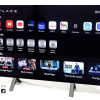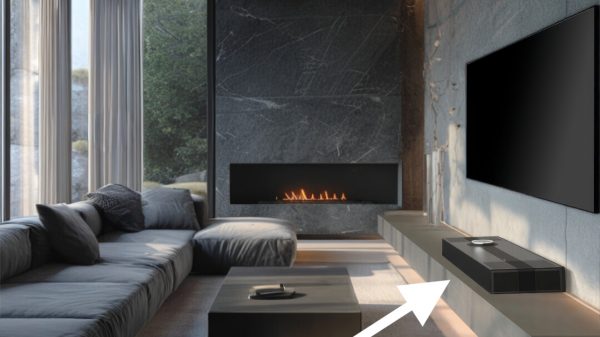One of the most annoying things when watching programs and movies on TV is sometimes not being able to understand voices clearly. Home theater receivers provide settings to adjust this somewhat, but ZVOX Audio’s Accuvoice TV Speaker products provide a simpler, and many times, more effective solution. Whether you have a hearing impairment or just want to enjoy a comfortable evening watching TV without fussing with audio settings on a home theater system to hear voices better, the ZVOX AV357 Accuvoice TV Speaker may be the solution for you.
The ZVOX Audio AV357 AccuVoice TV Speaker has some features that you will find on many soundbars, but its primary purpose is to make voices sound clear when viewing TV programs and movies. The AV357 is compact and easily fits in front of most TVs without blocking the bottom portion of the screen.
What You Get
The ZVOX AccuVoice 357 comes with the following:
- AccuVoice TV Speaker
- Detachable AC/DC Adapter
- Wireless IR remote control with batteries
- 1 digital optical cable
- 1 stereo mini-to-mini (3.5mm) cable
- 1 stereo mini-to-RCA cable
- User Manual and Warranty Card.

Features
Physical Design: The AV357 is 24-inches wide and is available in a black or cherry wood veneer wrapped MDF (Media Density Fiberboard) cabinet that houses the left, center, and right channel 2 x 3-inch, full-range speakers.
AccuVoice and SuperVoice: These features allow adjustment of human vocals and dialog so that they are clearer against other sounds. There are 6 Accuvoice and 6 SuperVoice modes that allow you to fine-tune the degree of vocal clarity to your preference. SuperVoice is especially useful for those that have a hearing impairment.
PhaseCue (SURROUND): This feature is a virtual surround sound processing system that provides a wider soundstage that is best suited for movies. When PhaseCue Surround is activated, the AccuVoice and SuperVoice features are disabled, but the PhaseCue settings do provide some voice enhancement.
Each PhaseCue setting provides more or less surround sound emphasis. If you choose a wider surround setting, there is a lessening of dialog presence, but it is still there, just not to the same degree as when using AccuVoice or SuperVoice.
Output Leveling (OL): This feature enhances the listening experience by leveling out volume spikes (such as the difference between commercials and regular programming), as well as making the voice/dialog levels more even with the rest of the sounds that may be present.
Audio Input Options: 1 x digital optical, 1 x 3.5mm analog stereo (also doubles as a second digital audio input for devices that use the mini-jack connector instead of a digital optical connector).
Audio Output Options: One Subwoofer/Headphone line output (3.5mm connection),
Control Options: Both onboard and wireless remote control options are provided. Also compatible with many universal remotes and some TV remotes for access to basic functions (Volume, Mute, and Power).
Alexa Ready: The AV357 doesn’t have Alexa built-in, but you can connect an Echo Dot, Echo Input, another Echo device that has analog audio output to the AV357 (more on this later in the review).

Set-up
1. Place the AV357 in front of the TV. However, before placing it to connect your TV, or audio sources to the unit.
2. Make your connections. If you are using the AV357 with just your TV, you have two connection options, Digital Optical or 3.5mm mini-Jack. Cables are provided.
3. If you have a Cable Box, Blu-ray Disc, or DVD player, you can also opt to connect the video source from those devices directly to your TV and use either Digital Optical or RCA-to-3.5mm mini-jack options to send audio only directly to the AV357.
TIP: Whether you connect your other source devices to the TV, and use the TV to pass the audio to the AV357, or split your audio and video source devices between the TV and AV357 is your choice – do what is most convenient for you.
4. The AV357 also provides an audio output that accommodates headphones or a subwoofer. The headphone connection provides a convenient listening experience when you don’t want to disturb others while connecting a subwoofer provides access to more realism for movie viewing. However, if you alternate listening time between headphones and the subwoofer, you will have to unplug the headphones or vice-versa, every time you want to use either the subwoofer or headphone option.
5. Once you settle in with AV357 placement and have everything else you want to be connected to the TV, plug the power in, put the provided batteries in the remote control, and start exploring what the AV357 can do.

Performance
The AccuVoice and SuperVoice features of AV357 were quite effective in bringing out vocal presence. However, as you choose to increase the Accuvoice/SuperVoice settings, voices and related sounds in the same frequency range may sound harsh.
For those that may have some hearing loss, the AccuVoice feature performs very well, and the SuperVoice feature goes beyond AccuVoice for even more effectiveness.
Vocals and dialog are brought forward and are very distinct against other sounds. If you don’t mind sacrificing not using the Phase Cue surround settings, AccuVoice and SuperVoice appear to be a great solution for those that have trouble hearing voices on TV programs.
Using the PhaseCue surround modes, there are varying degrees of voice emphasis, but the overall voice emphasis is not as pronounced as it is when AccuVoice is engaged. When using AccuVoice and SuperVoice, you can hear extreme vocal emphasis, which may be desirable for those that need it or prefer it, but when you engage the surround sound modes, you get a fuller overall soundstage, but voice emphasis is not as pronounced.
Also keep in mind that due to the narrow width of the AV357, the projected soundstage is not substantially wide.
The AV357 accepts Dolby Digital surround signals, but reprocesses them using PhaseCue. For Dolby Digital sources, switch the audio output settings of the source device bitstream if you are using the digital optical connection option to access the Dolby Digital signal.
The AV357 is not compatible with DTS. If you are playing a DTS-only audio source (some DVDs, Blu-ray Discs, and DTS-encoded CDs), you should set the digital audio output of the player to PCM if that setting is available.
Another alternative is to connect the TV or player to the AV357 using analog audio connections rather than the digital optical connection.
The Output Leveling (OL) feature does a good job of narrowing the difference between loud and soft sounds. This means that dynamic range is compressed, but for low volume listening, it really helps to maintain the volume of lower frequencies.
I had no problem hearing clear sound in a 15×20 room at a seating distance of about 6-8 feet. ZVOX states the power output for the AV357 as 40 watts (no reference parameters provided). The power output was more than adequate for TV and music listening, but not with the impact of a full home theater setup.
Using a test disk and streaming audio test apps, I found that there was a strong bass output down to 45-50Hz to a strong high-frequency output slightly over 13kHz before there was a sound level drop-off on both ends.
Although the AV357 has better bass response than you would expect from its compact design, for more impactful listening, an external subwoofer may be desired.
Using an External Subwoofer
If you add a subwoofer, here are some tips:
- Go with an affordable, compact subwoofer that has a good low-end frequency of about 30 – 35Hz.
- Find a spot in your room where the bass response of the subwoofer sounds best. However, don’t place the subwoofer right up against a wall, a subwoofer to wall distance of about 6-inches works best.
- Don’t set the subwoofer output level too high, as it will overwhelm the modest power output of the AV357. Once set up, the volume setting of AV357 keeps the speaker and subwoofer sound level relationship together.
- Set the subwoofer crossover between 80 to 100Hz to provide a smooth transition between the frequency range and output of the subwoofer and the AV357 speaker (you may have to experiment for best results).
Using Alexa
As mentioned in the previous “Features Section”, you can use a compatible Alexa device with the AV357. Here’s how:
- Connect your TV to the digital optical input of the AV357 (designated as In1d on the remote selection).
- Connect the Echo device to the AV357 via a 3.5mm audio cable (designated as In2A on the remote control selection).
- Set Input Selection to “both” by pressing and holding the Input button on the remote control for 5 seconds.
- If you are watching a TV program and ask Alexa a question, the AV357 will turn down the TV sound, while Alexa answers your question. When Alexa stops speaking, the AV357 turns the TV sound back up. You can also play music from any linked music streaming services on your connected Amazon Echo Dot or Echo Input, and hear it through the AV357.
- To switch back to just In1d or In2A, press and hold the Input button on the remote for 5 seconds.
NOTE: You can’t use Alexa to actually control the features of the AV357.
Final Take
The ZVOX AV357 AccuVoice TV Speaker delivers what it promises, clear voice reproduction.
This is a godsend not only for those that may have varying degrees of hearing impairment, but those that are just simply bugged by TV, DVD, Blu-ray discs, and streaming content that have vocal tracks that are just too subdued and want something simple to use to solve the problem.
The AV357 is available now for $299 at Amazon and other authorized outlets as well as ZVOX.com.
Pros
- Compact and easy to set up – Excellent User Guide.
- AccuVoice and SuperVoice features provide excellent vocal and dialog presence.
- Very good overall sound quality considering the size of AV357.
- Wider soundstage when PhaseCue surround processing is engaged.
- Large, easy-to-read front panel status display
- Accepts Dolby Digital encoded audio signals.
Cons
- Activating PhaseCue virtual surround sound deactivates AccuVoice and SuperVoice.
- The narrow form factor limits the effectiveness of the PhaseCue surround sound feature.
- Doesn’t accept DTS-encoded audio signals.
- No built-in Bluetooth capability.
- No HDMI-ARC/eARC or AV pass-through
- Pricey





































David H Miller
August 24, 2021 at 3:03 pm
I’ve owned two ZVOX products similar to this one and both failed. These devices were used to provide better sound in the kitchen area and they do an adequate job; just don’t expect it to last more than a year or two. To be fair, I experienced a similar result (works for awhile and then dies) with a Fluance AB40. Presently I’m using a Cambridge soundbase and that seems to be a better product. The Cambridge unit has an internal power supply (as opposed to a wall wart) and that seems to make a difference as far as reliability is concerned.
Ian White
August 24, 2021 at 6:19 pm
Reliability is huge for me. I have a list of companies that I won’t even look at based on bad experiences with their products.
Cheap wall-wart power supplies are a turn-off for sure but I’ve never had anything from Schiit Audio even burp so far in 4 years and many of those components came with wall-wart units.
Some brands don’t have solid QC and that’s a big problem regardless of price. I don’t care if a pair of speakers is $300 or $300,000 — build quality and reliability matters.
Best,
Ian White
Chris Williams
July 6, 2022 at 8:44 pm
Bad remote. Does not function. Company sending a new one by mail. No FedEx or UPS. Looking forward to reinstalling old Bose. Quality control problem. Back to Amazon? Save your Zvox box, kids.